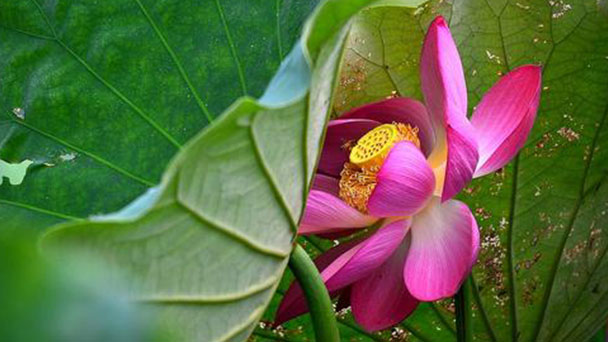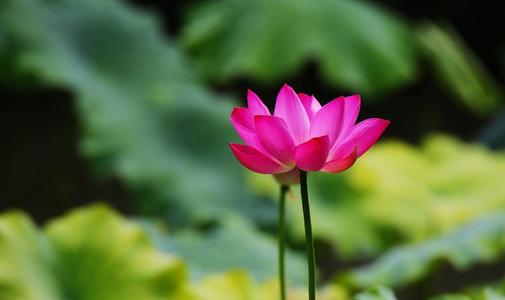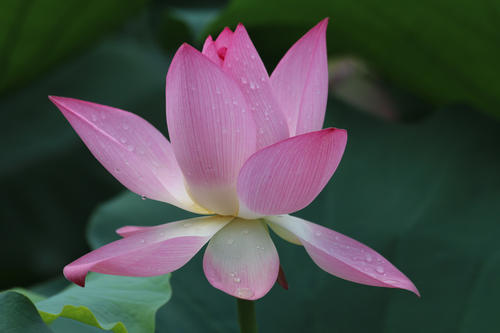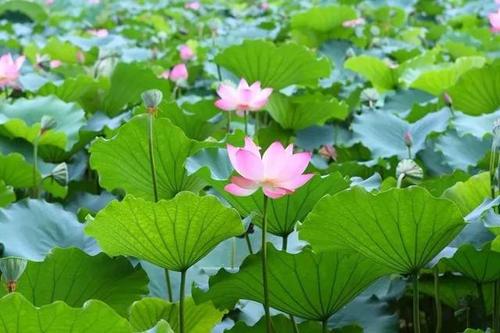Sacred lotus profile
Written by Maggie
Dec 18 2020

Sacred Lotus is a variety of Sacred lotus that comes in two major categories: ornamental and edible. It originated in tropical and temperate regions of Asia and was cultivated in China as early as the Zhou Dynasty. Sacred Lotus whole body treasure, lotus root and lotus seed can be eaten, lotus seed, root, lotus node, lotus leaves, flowers and seeds of the germ can be used as medicine. His unsullied character will always be praised by the world.
In May 1985, Sacred Lotus was named one of the top ten famous flowers in China. The Sacred Lotus flower is the national flower of India and Vietnam.
Sacred Lotus picture

Sacred Lotus morphological characteristics
Sacred Lotus is a perennial aquatic herb;Rhizome transverse, hypertrophic, internode dilated, with many longitudinal aeration channels, nodal constriction, black scaly leaves above, fringed adventitia roots below.
Sacred Lotus leaves are rounded, eluent, 25 -- 90 cm in diam., dark green, covered with waxy white powder, abaxially gray-green, entire slightly undulate, smooth above, with white powder, lower veins projecting from center, branched 1-2 times forked; The petiole stout, cylindrical, 1-2 m long, hollow, scattered spines outside.Pedicel and petiole equal or slightly long, also scattered small spines;Petiole cylindrical, densely barb.
Sacred Lotus flowers are solitary on top of pedicel, high above water, flowers 10-20 cm in diameter, beautiful, fragrant; There are single, double, double and double flower tables; The colors are white, pink, dark red, mauve, yellow or intercolor. Sacred Lotus leaf moment are oblong-elliptic to obovate, 5-10 cm long, 3-5 cm wide, from outside to inside gradually smaller, sometimes into stamens, apex round obtuse or slightly pointed, stamens many; Sacred Lotus pistil is free, buried in inverted conical spongy receptacle, receptacle surface with many scattered honeycomb holes, after fertilization gradually expanded called lotus, each hole in a small nut (lotus seed); Anther bar, filaments slender, born under the receptacle; Sacred Lotus style is extremely short, stigma apical; Receptacle (lotus chamber) 5-10 cm in diameter.
Sacred Lotus nuts are elliptic or ovate, 1.8-2.5 cm long, leathery, hard, dark brown when ripe;Seed (Lotus seed) ovate or elliptic, 1.2-1.7 cm long, seed coat red or white. Flowering from June to September, opening and closing at dusk every morning. Sacred Lotus fruit period August - October. There are many varieties of lotus cultivars, which can be divided into three systems according to different uses: Lotus root, lotus seed and lotus flower.
Sacred Lotus is one of the oldest dicotyledonous plants, and shares some of the characteristics of monocotyledons. The embryo of Sacred Lotus is covered with scales, similar to that of monocotyledons. From the structure of flowers, lotus has 3 or 4 layers of perianth, outer calyx flake, inner wheel petal shape, stamens many, pistil free, pollen grains are single gully boat shape. The stem of Sacred Lotus has an obvious segmented phenomenon, and the underground stem segment is overgrown with fibrous roots. These are all characteristics of monocotyledons. Sacred Lotus buds for mixed buds, people see lotus buds, lotus root is the top bud and each section of the position of axillary buds. The root is divided into two kinds: seed root and Adventist root. The taproot formed by the radicle of the seed is underdeveloped. The Adventist root plays a functional role. The stem of Sacred Lotus is lotus root, which is the underground rhizome of lotus. It is the organ for lotus to store nutrients and reproduce. Sacred Lotus flowers are solitary, bisexual, by calyx, corolla, stamen group, pistil group, receptacle, flower stem six parts.The varieties are varied and the colors are rich.
Sacred Lotus is an aquatic flower for stealing roots. Sacred Lotus root is a large underground stem in the silt of lotus. The cross section of the Sacred Lotus root has many holes of different sizes, which is the air cavity formed by Sacred Lotus to adapt to life in water. The same air cavity can be seen in petiole and pedicel. There are also many small vessels on the stem to transport water, the walls of which are thickened with mucilaginous lignocellulose. It has a certain elasticity, when broken elongated, so that many white connecting lotus root silk. The silk of the old Sacred Lotus root is more than that of the micro lotus root. The top bud of the plant is called "lotus root tomabechi" and is covered with scales. After it germinates, it produces the white tender slender underground stem, which is called "lotus root belt". The Sacred Lotus root is segmented and adventioned around the nodes. Take leaves and flowers from the nodes. The new lotus root formed from the apex of the lotus root is called the main lotus root. There are 4-7 segments of lotus root tube, which are 10-25 cm long and 6-12 cm in diameter. The main lotus root is divided into a branch lotus root and a subroot lotus root; The spring onion that grows again from child lotus root is called sun lotus root, often only 1 section. The size, shape, color, sooner or later, mud depth, quality and flavor of lotus root vary with varieties, and are affected by cultivation and conditions.
Sacred Lotus leaves are large, up to 70 cm in diameter, full range, shield-shaped circular, with 14-21 radial veins. Leaf surface is dark green, coarse, scattered with short blunt spines. A layer of waxy white powder between the thorns causes the rain to condense into rolling drops. Sacred Lotus leaves back are green, smooth glabrous, veins uplift, central cylindrical petiole lift lotus leaves water. The stem of the petiole is inversely rigid, the petiole is white at the junction with the underground stem, and the water and the water part are green. There are three kinds of leaves: the first leaves produced by the terminal bud, shaped small stalks thin, floating on the water. The first from the lotus root with long leaves slightly larger, also floating in the water, called floating leaves; Later from the lotus root with long straight water leaves called upright leaf. No matter if it is a money leaf, float leaf or stand leaf, it all rolls into a ribbed shape relative inside before water. According to the growth of the leaf early and late, its size, height, sequence showed obvious ladder and ladder. In the formation of a new lotus root out of the vertical leaves, than the front zhang and just thorn shorter, called "after the leaf", in front of a small shape, short stalk, leaf back slightly red leaves, called "termination leaf". As long as one can identify the terminating leaves, one can find the location of the new lotus root in the mud.

Sacred Lotus cultivation technique
The water quality
Sacred Lotus is an aquatic plant that can't live without water during its growth. In the early stage of growth, the water layer should be controlled at about three centimeters. Too deep water is not conducive to raising the earth temperature. If you use tap water, it should be put in another crock, bask in one or two days to use again. Summer is the peak of Sacred Lotus growth, the basin must not lack water. After the winter, the pot soil should also be kept moist to prevent the plant lotus root dry water.
Fertilization
Sacred Lotus uses phosphorus and potash fertilizer, supplemented by nitrogen fertilizer. If the soil is more fertile, fertilization may not be necessary throughout the year. Rotten cake fertilizer, chicken, duck and goose dung is the most ideal fertilizer, small pot in the application of two can, large pot can only apply at most 1-2 two, must not be more, and should be fully mixed with soil.Growth flourishing period. If discover leaf color yellow, emaciated, usable each box 0·5 grams urea is mixed in mud, rubbed into a ball of 10 grams or so, each basin applies a grain, applied in the soil in the center of the basin, 7 days take effect.
The winter
After winter, the basin can be placed indoors or buried under the permafrost. In the areas north of the Yellow River, agricultural film should be covered to remove the buried under the permafrost. The basin soil should be kept moist throughout the winter.
Sacred Lotus major value
Eating
In ancient China, there was a folk tradition of folding plums in spring and collecting Sacred Lotus in autumn. Since ancient times, Chinese people have regarded lotus seeds as a precious food. Nowadays, lSacred Lotus seeds are still a high-quality nourishing food. Many places specialize in the production of lotus seeds. Sacred Lotus root is the best vegetable and candied fruit. Sacred Lotus leaf, lotus flower, lotus stamen and so on are also Chinese people's favorite medicinal food.Visible lotus food culture is rich and colorful. Traditional Sacred Lotusseed congee, lotus breast, lotus seed powder, lotus root slices with meat, Sacred Lotus leaf steamed meat, Sacred Lotus leaf congee, etc. Leaf as a substitute for tea, and as a packaging material.
The underground stem of Sacred Lotus grows in silt, can be invaded by poisonous material, because the epidermal tissue of lotus root is special and close and contain tannin under the skin, have certain block or absorb poisonous material ability, as a result poisonous material more stick to go up in epidermis or permeate epidermis. When eating lotus root to peel off the skin, in order to prevent the toxic substances also eat into the belly.

Watch
Sacred Lotus is extremely adaptable to the environment in which it grows, not only in lakes and ponds but also in very small pots and bowls that it is graceful and graceful to decorate the world. In the history of Chinese Dutch culture, the form of basin lotus was only used for private courtyard appreciation at the beginning. Nowadays, basin Sacred Lotus is widely used in gardens all over China. The arrangement technique of combining potted plants with pond plants improves the ornamental value of Sacred Lotus, which often appears in garden waterscape and garden sketch. Sacred Lotus water stone bonsai is a new bonsai that appeared in Hangzhou. It is the organic union of lotus potted and water stone miniascence, reflecting the fortitude of mountain stone already, showing lotus again charming and charming. Sacred Lotus bonsai can choose coral stone, sand accumulation stone, axes stone, quartz stone as materials.
Latest Updated
- Benefits of Bugleweed - 7 Science-backed Health Benefits
- Bugleweed Dangers & Side Effects - Is It Poisonous?
- How to Plant Evergreen Trees - What You Should Know
- When to Plant Evergreens - Grow Guide for Evergreen Trees
- 12 Wonderful Evergreen Shrubs for Your Garden
- 12 Popular Evergreen Plants with Pictures for Beginners
- When And How To Prune A Lilac Bush Like a Pro
- How to Grow & Care for Lilac Vine (Hardenbergia Violacea)
- Japanese Lilac Tree (Syringa Reticulata) Care & Propagation Guide
- Shumard Oak Pros and Cons - What to Know
Popular Articles
- Winter maintenance of Antirrhinum Majus
- How to Grow Terminalia Mantaly Tree
- How to Grow and Care for Crossostephium Chinense
- How to grow Antirrhinum Majus in spring
- Peristeria Elata (Dove Orchid) Profile: Info & Care Guide
- Underwatered Snake Plant (Sansevieria Trifasciata) - Signs And How To Fix
- How to Care for Brazilian Jasmine Plant (Mandevilla Sanderi)
- How to Grow & Care for Graptopetalum Purple Delight in Summer
- Rosa Chinensis (China Rose): Plant Growing & Care Tips
- How to Care for Baby Sun Rose (Aptenia Cordifolia)